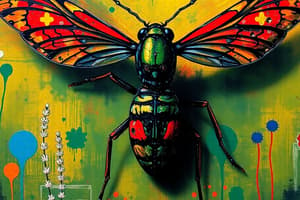Podcast
Questions and Answers
What is entomology primarily focused on?
What is entomology primarily focused on?
- The study of mammals
- The study of insects (correct)
- The study of plants
- The study of the environment
Which branch of entomology involves studying insects that impact human health?
Which branch of entomology involves studying insects that impact human health?
- Medical Entomology (correct)
- Economic Entomology
- Behavioral Entomology
- Forensic Entomology
Which of the following is NOT a type of metamorphosis found in insects?
Which of the following is NOT a type of metamorphosis found in insects?
- Partial Metamorphosis (correct)
- Complete Metamorphosis
- Incomplete Metamorphosis
- Gradual Metamorphosis
What component of insect anatomy provides protection and support to their body?
What component of insect anatomy provides protection and support to their body?
Which key insect order is known for being the largest group of insects?
Which key insect order is known for being the largest group of insects?
What type of entomology applies insect life cycles in criminal investigations?
What type of entomology applies insect life cycles in criminal investigations?
Which factor is considered a threat to insect conservation?
Which factor is considered a threat to insect conservation?
What is the role of pollinators in ecosystems?
What is the role of pollinators in ecosystems?
Flashcards are hidden until you start studying
Study Notes
Definition
- Entomology is the scientific study of insects.
Importance of Entomology
- Biodiversity: Insects are the most diverse group of organisms.
- Ecosystem Roles: Pollinators, decomposers, and food sources for other animals.
- Agriculture: Pest management, crop pollination, and beneficial insects.
- Medicine: Study of insects contributes to understanding diseases and developing treatments (e.g., venom research).
Branches of Entomology
- Economic Entomology: Focus on insects affecting agriculture and economics (pests and beneficial insects).
- Medical Entomology: Study of insects impacting human health (vectors of diseases).
- Forensic Entomology: Application of insect life cycles to determine time of death in criminal investigations.
- Taxonomy and Systematics: Classification and identification of insect species.
- Behavioral Entomology: Study of insect behavior and interactions.
- Ecological Entomology: Insects' roles within ecosystems and their interactions with other organisms.
Insect Anatomy
- Body Structure: Divided into three main parts: head, thorax, abdomen.
- Exoskeleton: Tough outer structure made of chitin providing protection and support.
- Wings: Present in many species; vary in number and structure.
- Antennae: Sensory organs for detecting chemicals, vibrations, and other environmental cues.
Life Cycle
- Metamorphosis Types:
- Complete Metamorphosis: Four stages (egg, larva, pupa, adult) – e.g., butterflies.
- Incomplete Metamorphosis: Three stages (egg, nymph, adult) – e.g., grasshoppers.
Identification
- Morphological Features: Body size, shape, coloration, wing structure, and antennae types.
- Taxonomic Keys: Tools used for identifying and classifying insects based on physical characteristics.
Conservation
- Threats: Habitat loss, pollution, climate change, and invasive species.
- Importance of Conservation: Protecting insect biodiversity is crucial for ecosystem health and human survival.
Current Research Areas
- Insect Genomics: Understanding genetic makeup to study evolution and adaptability.
- Pest Management: Development of sustainable practices to control harmful insect populations.
- Pollinator Decline: Research on the causes and solutions to declining pollinator species.
Key Insect Orders
- Coleoptera: Beetles – largest order of insects.
- Lepidoptera: Butterflies and moths – known for their scales and colorful appearances.
- Diptera: Flies and mosquitoes – important as pollinators and disease vectors.
- Hymenoptera: Bees, ants, and wasps – crucial for pollination and social behavior studies.
Tools and Techniques
- Field Sampling: Collecting insects using nets, traps, and baits.
- Molecular Techniques: DNA barcoding for species identification.
- Microscopy: For detailed morphological examination.
Future Trends
- Increasing use of technology (e.g., drones, AI) in insect monitoring and research.
- Growing interest in urban entomology due to human-insect interactions in cities.
Definition
- Entomology is the scientific discipline focused on studying insects.
Importance of Entomology
- Insects represent the most diverse group of organisms on the planet.
- They play crucial ecosystem roles, serving as pollinators, decomposers, and providing food for other species.
- In agriculture, entomology aids in pest management, crop pollination, and the identification of beneficial insect species.
- Research on insects leads to advancements in medicine, including understanding diseases and developing treatments through venom studies.
Branches of Entomology
- Economic Entomology examines the impact of insects on agriculture and economics, including pests and beneficial species.
- Medical Entomology focuses on insects that pose threats to human health, especially as vectors for diseases.
- Forensic Entomology utilizes insect life cycles to estimate time of death in forensic investigations.
- Taxonomy and Systematics is dedicated to the classification and identification of insect species.
- Behavioral Entomology investigates the behaviors and interactions of insects within their environments.
- Ecological Entomology studies the ecological roles of insects and their relationships with other organisms.
Insect Anatomy
- Insects have a body divided into three primary segments: head, thorax, and abdomen.
- They possess an exoskeleton made of chitin, providing structural support and protection.
- Many insects have wings, which can vary significantly in both number and structure.
- Antennae serve as sensory organs, allowing insects to detect chemicals, vibrations, and other environmental signals.
Life Cycle
- Complete metamorphosis involves four distinct stages: egg, larva, pupa, and adult (e.g., butterflies).
- Incomplete metamorphosis consists of three stages: egg, nymph, and adult (e.g., grasshoppers).
Identification
- Morphological features such as body size, shape, coloration, wing structure, and antennae types are essential for insect identification.
- Taxonomic keys are systematic tools designed to classify and identify insect species based on observable physical characteristics.
Conservation
- Insects face significant threats from habitat loss, pollution, climate change, and invasive species.
- Maintaining insect biodiversity is vital for supporting ecosystem health and human existence.
Current Research Areas
- Insect genomics focuses on analyzing genetic data to enhance understanding of evolution and adaptability.
- Pest management research aims to develop sustainable strategies for controlling harmful insect populations.
- Investigation into pollinator decline addresses the causes and potential solutions for the decreasing numbers of pollinator species.
Key Insect Orders
- Coleoptera includes beetles, the largest insect order.
- Lepidoptera encompasses butterflies and moths, noted for their colorful scales.
- Diptera consists of flies and mosquitoes, which play significant roles as pollinators and disease transmitters.
- Hymenoptera includes bees, ants, and wasps, crucial for pollination and studies of social behavior.
Tools and Techniques
- Field sampling methods involve collecting insects using nets, traps, and baits.
- Molecular techniques such as DNA barcoding facilitate species identification.
- Microscopy provides a means for detailed examination of insect morphology.
Future Trends
- Technology adoption is increasing in insect monitoring and research, including the use of drones and AI.
- Urban entomology is gaining attention due to the rising interactions between humans and insects in urban environments.
Studying That Suits You
Use AI to generate personalized quizzes and flashcards to suit your learning preferences.




